I’ve spent a ton of time hiking through natural habitats over the years, and I’ve occasionally found a tick clinging to me or my dog afterward. This never really bothered me; I just pulled the tick off and went on with life.
So, when I woke up one morning this summer with a tick embedded in my arm, I didn’t think much of it.
It surely crawled off my pup overnight, crawled onto me, and started feasting. As I had done many times before, I pulled the bloodsucker off, kept calm, and carried on.
But three days later, I noticed that the bite wound was getting pretty gross. It turned completely black and started tingling.
Fast forward to the eighth day following the bite, and I wake up feeling terrible. I was as sick as I’d ever been in my life. My head was pounding, my muscles were aching, and I was running a pretty high fever.
I’ll talk more about my story below and identify a few of the best tick-preventing options available. But if you’re just looking for quick recommendations, check out our quick picks!
Quick Picks: Best Flea and Tick Treatments For Dogs
- Pick #1: Seresto Flea and Tick Collar — The Seresto Flea and Tick Collar is an easy-to-use collar that protects your dog from fleas and ticks. It is a bit pricey, but it is effective for up to 8 months, making it a fantastic value.
- Pick #2: K9 Advantix II — K9 Advantix II not only kills fleas and ticks, it actually repels ticks to help keep them from climbing on your dog in the first place. It is also effective at repelling mosquitoes, which can help reduce the chances of your dog developing heartworm disease.
- Pick #3: Virbac Preventic Tick Collar — The Preventic Collar is effective for 90 days, and it is designed to kill ticks before they even bite your dog. It’s also easy to take off when your pup goes swimming or needs a bath.
Danger of Ticks – My Close Encounter With Rocky Mountain Spotted Fever
Given that I was recently bitten by a tick and had suddenly developed a fever, I began consulting Google M.D.
Unfortunately, my symptoms and the timing of their onset strongly suggested that I had contracted Rocky Mountain Spotted Fever (RMSF) – a very serious illness.
The disease not only causes a variety of very troubling symptoms, but it is also occasionally fatal.
In fact, it killed more than one in four people who contracted it before treatments became available around World War II.
But death isn’t the only potentially tragic outcome of RMSF: It can also cause permanent mental disabilities and hearing loss. In some cases, limb amputations even become necessary.
This caused me to freak out pretty thoroughly, so I drove right over to the emergency room.
Upon arriving, the doctor explained that RMSF is one of those diseases that is easier (and cheaper) to treat than it is to diagnose. And because he agreed that my symptoms were consistent with RMSF (or a related tick-borne disease), he prescribed Doxycycline – the antibiotic of choice for dealing with most tick-borne diseases – and sent me on my way.
Thankfully, I started feeling better a few days later. I was extremely lucky – many people contract RMSF without noticing a tick bite. This can make it very difficult for doctors to diagnose the illness, as it mimics so many other diseases. This often results in delayed treatment, which increases the odds of suffering serious sequelae.
The whole ordeal taught me to take ticks more seriously than I previously had. And that not only means protecting myself from ticks but protecting my pooch too.
After all, dogs may not only bring ticks back to your home, they are also susceptible to a number of tick-borne diseases.
We’ll share some good tick-prevention strategies below so that you can hopefully avoid these types of problems. This includes using a good preventative tick treatment for your dog.
But we’ll start by introducing you to the most common ticks in the U.S. and explaining some of the most notable diseases they can carry.
Common Ticks Found in the United States
Ticks are arachnids, like spiders, scorpions, and mites, but we’ll forgive you if you just want to call them bugs.
There are roughly 900 tick species worldwide, but only a relative handful represent a risk to owners and pets living in the U.S. Different species live in different regions and carry different diseases, so it makes sense to familiarize yourself with those living in your neck of the woods.
This doesn’t mean you need to become a tick-identifying expert. In fact, tick identification is very difficult for amateurs, so anytime you pull a tick off you or your pet, you’ll want to preserve it so that your doctor or vet can have it positively identified.
Nevertheless, the following five species cause the majority of the problems in the U.S.
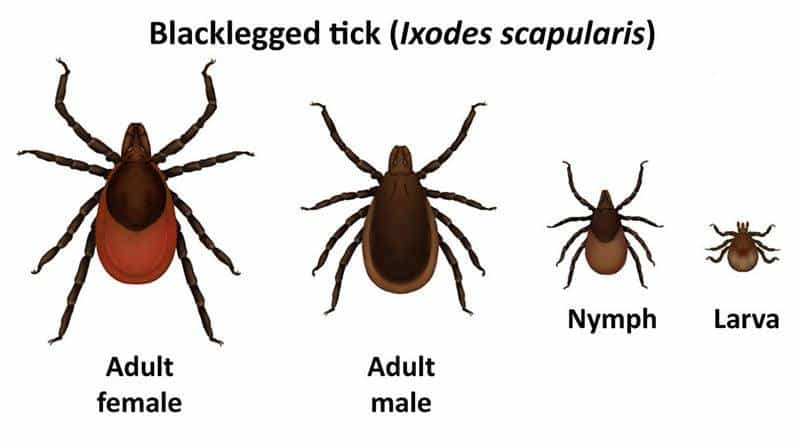
Blacklegged Tick Photo from Vermont.gov.
Blacklegged Tick (Ixodes scapularis) – Found across the eastern half of the country, the blacklegged tick can carry Lyme disease as well as several other serious infections. It is most active during the summer, but bites can occur during any time of the year, including unseasonably warm periods during the winter.
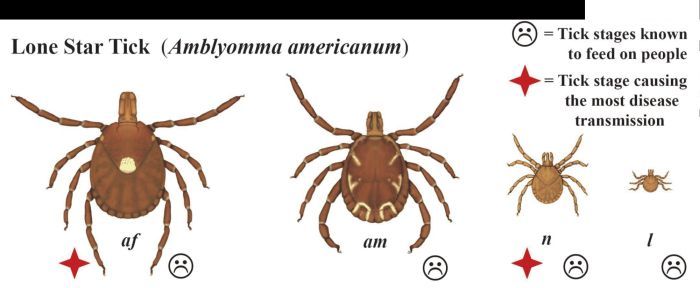
Lone Star Tick Photo from Virginia Department of Health.
Lone Star Tick (Amblyomma americanum) – Most common in the southeast, the Lone Star tick is named for the single, white star-like marking on the backs of mature females. The CDC characterizes this tick as a “very aggressive” species that frequently bites people. It can transmit ehrlichiosis, tularemia, and several other serious diseases.
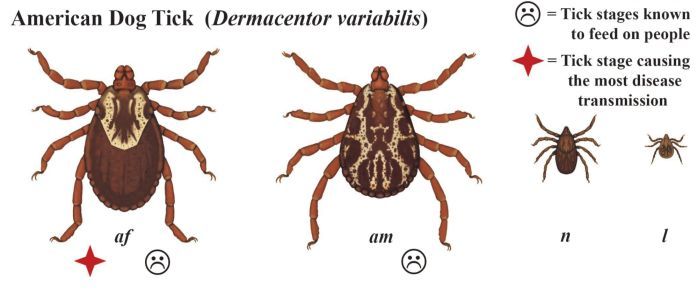
American Dog Tick Photo from Virginia Department of Health.
American Dog Tick (Dermacentor variabilis) – Found east the Rocky Mountains and throughout portions of the Pacific coast, the American dog tick is one of the tick species that is most likely to bite humans. Also, as their name suggests, they often feed on dogs. The most common diseases these ticks carry include RMSF and tularemia.
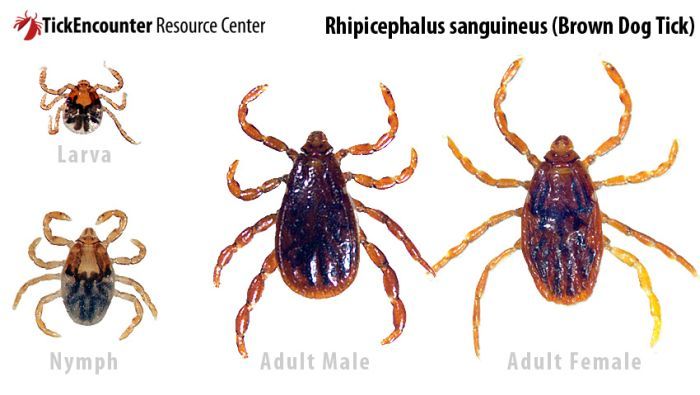
Brown Dog Tick Photo from University of Rhode Island Tick Encounter Resource Center.
Brown Dog Tick (Rhipicephalus sanguineus) – The brown dog tick primarily feeds on dogs, but they will also feed on humans. Found all over the world, the brown dog tick is a common vector for the spread of RMSF.
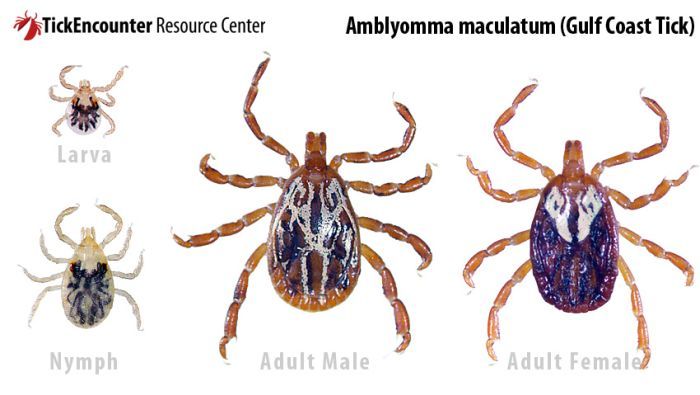
Gulf Coast Tick Photo from University of Rhode Island Tick Encounter Resource Center.
Gulf Coast Tick (Amblyomma maculatum) – Gulf Coast ticks are primarily native to a swath of land along the coastal plain, stretching from Virginia to Arizona. They may be found inland as far as Kansas and southern Missouri. The most notable disease they spread is an RMSF-like condition caused by an organism called Rickettsia parkeri.
Serious Diseases Spread by Ticks
Rocky Mountain Spotted Fever isn’t the only serious disease spread by ticks.
In fact, the CDC reports that 16 different tickborne diseases are found in the U.S. We’ll describe a few of the most dangerous diseases below.
Note that different diseases are prevalent in different portions of the country, so be sure to do your homework and familiarize yourself with the greatest threats in your region.
→ Rocky Mountain Spotted Fever
Despite its name, RMSF is not confined to the Rocky Mountain region.
It is most common in the “tick belt,” which stretches across portions of North Carolina, Tennessee, Arkansas, Missouri, and Oklahoma.
Most people who contract the disease will suffer from a high fever, and many will eventually develop the characteristic rash, consisting of small, painless red spots, although this often takes two to four weeks to manifest.
Rocky Mountain Spotted Fever is caused by a bacterium called Rickettsia rickettsia which infected ticks carry in their saliva. However, there are several other, closely related bacteria, which cause similar diseases. This includes R. parkeri and R. akari, among others. These bacteria typically cause comparable, albeit slightly milder, illnesses, than RMSF.
Quick Aside: I don’t believe I caught the most serious form of RMSF, as R. rickettsia rarely causes an eschar (the black wound that developed on my arm). Instead, it is likely that I was infected with R. parkeri, which typically does cause such a wound. I only bring this up to say that if I was only suffering from a “mild” version of RMSF, then I pity those who contract the “severe” forms of the condition. I can’t imagine feeling much worse than I did.
Dogs are highly susceptible to RMSF (and, in all likelihood, illnesses caused by related bacteria).
It can cause a host of symptoms, ranging from difficulty breathing, coughing, diarrhea, painful joints, vomiting, and a rash affecting the eyelids and mouth.
Canine antibiotics are generally effective for treating the disease in dogs, but 1% to 10% of infected dogs die from the disease.
→ Lyme Disease
Lyme disease often appears in the headlines, thanks to the serious and slightly perplexing nature of the disease.
Most common in the northeastern United States, the disease is caused by a bacterium called Borrelia burgdorferi, which is spread by black-legged ticks.
Lyme disease causes a variety of unpleasant symptoms, including fever, headache, fatigue, and joint pain. It also causes a characteristic bullseye-shaped rash in many cases.
Lyme disease can be treated with antibiotics, although some individuals seem to suffer long-lasting complications after contracting the disease.
Often called “chronic Lyme disease,” (or post Lyme disease syndrome), this long-term health problem remains poorly understood and difficult to treat, thereby highlighting the importance of prevention.
Dogs can also become infected with the bacteria that causes Lyme disease – but it doesn’t always make them sick. In fact, 50% to 75% of dogs in New England will test positive for the disease, while only a small percentage of those display symptoms.
Be grateful for that, as the disease can make dogs pretty sick.
Severe lethargy and fever are the most common symptoms associated with the disease, but they rarely appear until several months after being infected. Fortunately, most dogs will recover following an antibiotic regimen.
→ Ehrlichiosis
Ehrlichiosis is a disease that causes muscle aches, fever, and headaches, although mental confusion and intestinal upset are also reported by many who suffer from the illness.
Children infected with the disease often display a rash, but this is fairly rare among adults.
Ehrlichiosis is caused by any of several different bacteria belonging to the genus Ehrlichia; however, E. chaffeensis is the most common culprit.
Like many other tick-borne diseases, Ehrlichiosis is treatable with a course of doxycycline, but it is important to begin the regimen promptly to avoid serious illness.
Left untreated, Ehrlichiosis can cause brain damage, respiratory failure, clotting failures, organ failure, and – in extreme cases – death.
The disease is found across much of the eastern United States, although, like many other tick-borne diseases, it is most commonly diagnosed in those living in the “tick belt” (a swath of land that includes portions of North Carolina, Tennessee, Arkansas, Missouri, and Oklahoma).
Dogs can also get Ehrlichiosis. They’re normally infected by E. canis, an organism related to the one that affects humans.
The disease often occurs in three different phases in dogs, including an acute phase when symptoms first appear, followed by a sub-clinical stage in which your dog remains infected but doesn’t display symptoms.
The third stage causes a variety of very serious symptoms, including swollen limbs, anemia, lameness, and neurological problems.
The disease is often tricky to diagnose, but it usually responds well to antibiotics. However, you’ll usually need to administer these antibiotics over a long period of time – up to 6 weeks in some cases – to completely cure your pet.
→ Tularemia
Tularemia is a pretty scary disease, which normally affects rabbits and rodents (it’s often called “rabbit fever”). However, it can also be transmitted to people through tick bites, insect bites, and the inappropriate handling of dead animals.
Caused by a bacterium called Francisella tularensis, tularemia can cause a variety of different symptoms, depending upon which tissues become infected.
Skin lesions often occur when the disease enters via a bite, but the disease can also cause glandular problems, eye infections, and respiratory disease. A high fever is typically seen in all cases.
Tularemia was 60% fatal before the development of antibiotics, but with antibiotic treatment, most people eventually recover. However, the recovery process is often quite lengthy, and patients often feel sick for several weeks following exposure, even once treatment has begun.
Dogs can also get tularemia, but, fortunately, infections are pretty rare. Those who do contract the bacterium often develop a high fever, their lymph nodes may become swollen and painful, and their eyes will yellow.
It can sometimes be treated, but the disease is difficult to diagnose, and treatment usually involves hospitalization.
Unfortunately, tularemia is often fatal for dogs – even with treatment.
→ Heartland Virus
Heartland virus is a relatively newly discovered disease.
The first documented cases occurred in 2009, and the causative agent wasn’t even identified until 2012. Accordingly, scientists don’t yet understand the disease very well.
Heartland virus causes symptoms that generally resemble those of other tick-borne diseases – headaches, fever, muscle aches, and intestinal upset – but they are often much more severe.
In fact, the majority of people who contract the illness require hospitalization. A few people have even died from the disease.
Unlike many of the other tick-borne diseases, which are caused by bacteria, Heartland is caused by a virus. This means that it is not treatable with antibiotics – most therapies are supportive in nature.
The virus is thought to be spread via the bites of several different insects and ticks, although some scientists contend that this is speculative and yet to be empirically established.
Heartland virus was originally thought to be restricted to the tick belt, but it has recently been detected in deer and raccoons throughout the eastern half of the country.
Scientists don’t yet know whether or not dogs can contract the illness.
→ Meat Allergy
Tick bites can also trigger meat allergies in people. Most cases of tick-initiated meat allergies have been attributed to bites from the Lone Star tick, but they can also occur in response to bites from other ticks.
Meat allergies tend to cause people to suffer from symptoms including runny noses, rashes, hives, and nausea after eating meat. These reactions typically occur after eating red meat, and the allergies tend to occur for the rest of the patient’s life.
Fortunately, through a quirk of biological chemistry, primates are likely the only mammals at risk of these allergies.
We don’t yet know for sure if dogs can develop meat allergies in response to a tick bite, but it seems highly unlikely.
Preventing Tick Bites In Dogs & Yourself
Now that I’ve given you plenty of nightmare fuel about ticks and the diseases they carry, it’s time to talk about prevention.
There are myriad strategies you can employ to help reduce the chances of being bitten by one of these blood-sucking arachnids, but the following three should be considered mandatory:
1. Use an effective tick treatment for your dog.
There are two important reasons to protect your dog from ticks.
First, as explained above, they can transmit diseases that will make your pup very sick. Most tick-borne illnesses that befall dogs can be treated, but your pooch will feel awful during the process and treatment will likely cost a fortune.
Additionally, as illustrated by my experience, ticks can hitch a ride home on your dog, hop off your pet, and crawl up on you.
This is a particularly troubling issue, as it increases the chances that you’ll suffer a bite without noticing. Even if you perform tick checks after every walk, you’re unlikely to do so after sitting on the couch or sleeping beside your pup.
2. Wear permethrin-treated clothing.
Permethrin-treated socks are one of the most effective ways to prevent ticks from crawling up your legs (the most common way ticks get onto people).
By wearing a pair of permethrin-coated socks, you can ensure that any that try to crawl up your leg will be killed before they can make it very far.
You can also purchase other permethrin-treated articles of clothing, including shorts, shirts, and bandanas. These items certainly offer additional protection, but if you only want to buy one type of treated clothing, go with socks.
You can also purchase permethrin-based sprays, which you can then use to treat your own clothes.
3. Apply an EPA-registered repellent to your skin.
Permethrin-treated clothing should be considered your first line of defense against tick bites, but it won’t provide much protection for exposed skin.
So, you’ll also want to use a repellent containing DEET, Picaridin, or some other EPA-registered chemical that has been shown effective against ticks.
This is important, as most repellents are primarily designed to repel mosquitos – only a few repel ticks.
We’d recommend going with Sawyer Products Insect Repellent if you want a picaridin-based repellent, or OFF! Deep Woods Spray if you want a DEET-based repellent.
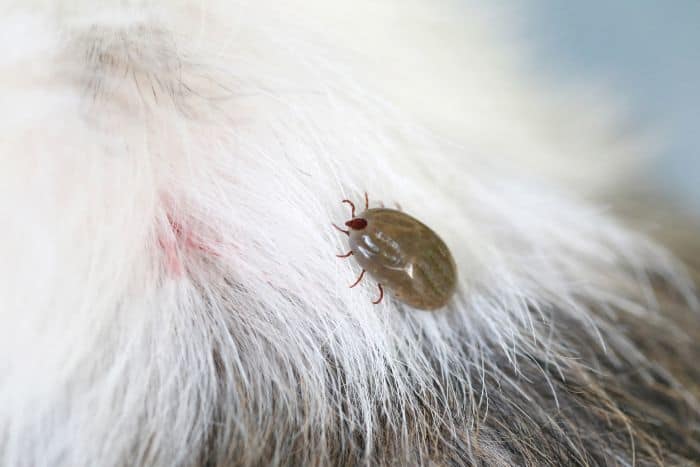
Protect Your Pooch: Drugs and Chemicals That Kill or Repel Ticks
There are a number of different products that you can use to help keep ticks off your dog, and they use a variety of different active ingredients. We’ll discuss a few of the most notable examples below.
Fipronil
Fipronil is an insecticide in the phenylpyrazole chemical family.
Fipronil kills both fleas and ticks, but unfortunately, it takes about 24 to 48 hours to kill ticks. This can give the ticks enough time to transmit a disease to your dog or jump off your dog and crawl onto you.
Additionally, it appears possible that some fleas are evolving resistance to fipronil, although it remains to be seen whether ticks are evolving similar resistance.
Fipronil is safe for cats, so you don’t have to worry about keeping your pets separated after the application (although some fipronil-based products may contain other chemicals which are dangerous to cats).
Fipronil is administered topically, and it is available over-the-counter in Frontline Plus and a few other products.
Permethrin
Permethrin is a synthetic pyrethroid that works similarly to extracts taken from the chrysanthemum flower.
In high concentrations, it is effective for not only killing ticks, but repelling them too. Permethrin also kills fleas, making it one of the most common active ingredients used in flea and tick treatments.
While permethrin can occasionally cause skin irritation, it is widely considered safe for people and dogs.
However, it is very dangerous to cats. Accordingly, you should not only refrain from using permethrin-containing products on your feline pet, but you should also take steps to ensure that your cat doesn’t come into contact with your dog until the drug has been completely absorbed by your dog’s skin.
Permethrin is administered topically and it is available over-the-counter in products like K9 Advantix II.
Flumethrin
Like permethrin, Flumethrin is another drug in the pyrethroid class which works by disrupting the sodium channels in the nervous systems of ticks and fleas.
Flumethrin is largely considered safe for dogs, and, unlike permethrin, flumethrin appears safe for use in cats too.
However, flumethrin has been reported to cause mild skin irritation and, rarely, temporary hair loss in dogs.
Flumethrin is used in Seresto, an over-the-counter flea-and-tick collar produced by Bayer.
Note that flumethrin is not effective against fleas, but the Seresto collar also features imidacloprid, an effective flea-killing ingredient.
Fluralaner
Fluralaner is a member of the isoxazoline class of drugs. It works by inhibiting the nervous system of ticks, fleas, and some lice.
Fluralaner kills ticks very quickly, which can help prevent disease transmission.
Fluralaner also comes in an easy-to-administer oral tablet that is typically flavored to suit your dog’s palate.
The pill is effective for about 12 weeks, which is also pretty convenient – you only have to administer it four times per year, and you don’t have to worry about your dog swimming after use the way you do with some topical products.
Currently, Fluralaner is only available with a veterinary prescription.
Lotilaner
Lotilaner is another isoxazoline drug that works somewhat similarly to fluralaner. It is effective for killing fleas and ticks.
It is given as an oral tablet, and it remains effective for about 1 month of use. It hasn’t been around for very long (safety tests were only carried out in November of 2017), which may give some owners pause.
Lotilaner is only available with a veterinary prescription.
Afoxolaner
Another isoxazoline drug, afoxolaner works in the same way that lotilaner and fluralaner do, by disrupting the nervous system of fleas and ticks. Afoxolaner is used in Nexgard Chewables, which are only available with a prescription.
Although it doesn’t provide any repellant value, afoxolaner kills fleas and ticks very quickly – generally within 8 hours. This is very helpful for reducing the chances that your dog will contract a disease from the tick’s bite. Each dosage continues to kill ticks for 30 days.
While generally recognized as safe, afoxolaner occasionally causes vomiting, and some dogs appear to find the tablets unpalatable.
Amitraz
Amitraz is a monoamine oxidase inhibitor that is used in the Preventic Pet Collar by Virbac. It is only effective for killing ticks, so you’ll have to use an additional product for your pet’s fleas.
That said, it kills ticks pretty quickly. Most ticks will die within 6 hours of contact with your dog – this means many will die before they have a chance to bite your pet.
This formulation is effective for up to 3 months, although you’ll need to be sure that your dog doesn’t go swimming, as this will reduce the efficacy of the collar.
Amitraz is largely considered safe for use in collar form, but it is very toxic if ingested, so caution is required with dogs that tend to eat inedible items.
The Preventic Pet Collar is available over the counter.
Selamectin
Selamectin is in a class of drugs known as macrocyclic lactones.
It kills or disrupts the lifecycle of several different parasites, including adult fleas (it also prevents flea eggs from hatching), dog ear mites, sarcoptic mange mites, lice, hookworms, and roundworms. It is also effective for preventing heartworm disease.
However, selamectin is only effective for killing one species of tick – the American dog tick. This means you and your dog will still be at risk of contracting diseases carried by other tick species.
Selamectin is available in Revolution, a topical one-spot treatment, but you’ll need a prescription from your vet to purchase it.
Types of Tick Treatments For Dogs
There are a few different types of products that can help protect your dog from ticks, including pills, topical liquids, and collars.
Each presents a different set of pros and cons, and none of the three is inherently better than the others.
Topical Liquids
Topical liquids are often available over-the-counter, and they usually provide protection from ticks (and fleas) for about 30 days or so.
They can be a bit messy, and you’ll need to keep your cat away from your dog until it is completely absorbed if you are using a product that isn’t safe for cats.
Note that you may have to refrain from bathing your pet (or letting her swim) for a few days following treatment. Just be sure to follow the product instructions for maximum efficacy.
Tick Collars
Tick collars offer an easy way to protect your dog from ticks. The nice thing about collars is that most can be removed when you are indoors, and they usually last for a very long time.
On the other hand, many collars are toxic if eaten, which may represent a danger for pets who are problem chewers.
Oral Tablets
Oral tablets are likely the most convenient way of protecting your pet from ticks, and they won’t represent a danger to any of your other pets.
However, there aren’t any over-the-counter oral tablets on the market – they all require a prescription.
Tick Shampoos
There are also a few shampoos that will kill ticks, but they are generally only effective for killing ticks that are already crawling around on your dog.
Generally speaking, these products are primarily intended for eradicating fleas – their tick-killing properties are generally just a side effect of the medications used to kill the fleas on your dog.
Nevertheless, they may be helpful if your dog becomes covered in a large number of ticks. Just be sure to follow all of the product instructions when using these types of products.
The Five Best Flea and Tick Treatments For Dogs
The following five products are among the best for protecting your dog from ticks. Be sure to follow the directions included with each product.
1. Seresto Flea and Tick Collar for Dogs
The Seresto Flea and Tick Collar is a flumethrin-and-imidacloprid-based product that will kill fleas and ticks on your dog’s body for up to 8 months.
- Vet-recommended, premium flea & tick protection for dogs & puppies without the price tag
- Long-lasting flea collar kills & repels fleas for 8 continuous months
- Seresto is the #1 veterinarian recommended flea & tick collar (Based on survey data, 2023)
- Starts working within 24 hours to kill & repel fleas by contact so pests don’t have to bite your...
Features: The Seresto Flea and Tick Collar comes in two sizes – one for dogs who weigh less than 18 pounds, and another that is for dogs who weigh more than this.
It features a small buckle-like fastener, which makes it easy to achieve a proper fit and also gives you the chance to remove the collar when you are not walking through tick country.
The dog flea collar works by slowly releasing the active ingredients which are then redistributed all over your pet’s body. Any fleas or ticks who then crawl on your dog’s body will be killed – before they even bite your pet.
But it not only kills fleas and ticks, it repels them too, which reduces the number of bugs crawling on your pet in the first place.
PROS
Most owners who tried the Seresto Flea and Tick Collar were pleased with the product. Most noted that it worked very well and prevented ticks from infesting their dog. Several owners also mentioned that, unlike some other flea and tick collars, the Seresto Collar was not greasy and did not produce an offensive odor.
CONS
A few owners noted that their dog experienced side effects after using the collar. A few noted hives appearing, but the most common complaint was nausea or hyperactivity. A few owners also complained about the price of the collar, but when you consider the length of time the collar lasts, the Seresto Collar is actually quite affordable.
2. Frontline Plus
Frontline Plus is a topical treatment that uses fipronil and (S)-methoprene (a growth regulator used to control flea infestations) to protect your dog from ticks and fleas.
- Keep your dog protected from fleas & ticks all month long with FRONTLINE Plus for Dogs a...
- Break the flea life cycle with FRONTLINE Plus. Specially formulated with fipronil and (S)-methoprene...
- Trusted by pet owners for over 20 years, FRONTLINE Plus for Dogs can be used on puppies as young as...
- FRONTLINE Plus also comes in a formula designed for cats and kittens eight weeks of age and older,...
Features: Frontline Plus is an easy-to-apply topical treatment you’ll need to put on once a month to keep your dog protected from ticks (routine flea control only requires treatment every other month).
The active ingredients will spread through your dog’s skin and kill any fleas or ticks that bite your dog. 48 hours after applying the medication, your dog can bathe or swim as she normally would.
Frontline Plus is available in several different strengths for dogs of different sizes.
One is appropriate for dogs between 5 and 22 pounds, one is designed for pets between 23 and 44 pounds, one is formulated for dogs between 45 and 88 pounds, and one is made for dogs between 89 and 132 pounds.
PROS
Most owners found that Frontline Plus kept their dog tick-free and that it also eliminated any fleas living on their pet. The topical liquid was reportedly easy to apply, and adverse reactions to the product were exceedingly rare.
CONS
Generally speaking, complaints about Frontline Plus were rare. The biggest problem with the product is that, like many other fipronil-based products, it kills ticks slowly and only after they bite your pet. This may allow the ticks enough time to transmit diseases to your pet.
3. K9 Advantix II
K9 Advantix II is a topical flea and tick medication that is formulated with permethrin, imidacloprid, and pyriproxyfen (the former will kill ticks and fleas, while the latter two are directed solely at fleas).
- K9 Advantix II Extra Large Dog 30-day treatment & prevention protects dogs over 55 lbs. from fleas,...
- Kills fleas within 12 hours of application
- Vet-recommended formula kills & repels on contact so fleas don’t have to bite your dog to die
- Easy-to-apply topical treatment is fragrance-free and waterproof after 24 hours
Features: K9 Advantix II is a topical liquid you’ll need to apply to your dog once each month.
Unlike some other topical treatments which only kill ticks that bite your dog, this one kills through contact, which will help provide additional protection against tick-borne diseases.
K9 Advantix II also works to repel ticks, which will reduce the number of blood-suckers crawling on your pet. It even repels mosquitoes and biting flies, which your dog will surely appreciate.
K9 Advantix II is available in four different formulations for pets of different sizes. One is designed for pets between 4 and 10 pounds, another is for pets between 11 and 20 pounds, one is designed for 21- to 55-pound pets, and one is for pets over 55 pounds.
PROS
Most owners praised K9 Advantix II and reported that it protected their dog from ticks. It appears easy to apply, and many owners were satisfied with the product’s ability to repel ticks, as well as kill any that did crawl on their dog. A few owners also mentioned that they were happy with the product’s price and found that it provided great value.
CONS
A small number of dogs experienced skin irritation or neurological symptoms after application, but such reports were quite rare. It is, however, important to note that K9 Advantix II is not safe for cats, and you should keep your cat away from your freshly treated dog until the medication is completely absorbed.
4. Virbac Preventic Tick Collar
The Preventic Tick Collar is an amitraz-based collar that kills ticks for up to 90 days.
No products found.
Features: The Preventic Tick Collar is an easy-to-use pet collar that is designed to kill ticks before they attach to your dog.
It features a simple clasp that helps keep it securely attached to your dog’s neck, but also makes it easy to take off your dog’s neck while swimming or being bathed (rain should not affect the efficacy of the collar).
The Preventic Tick Collar provides 90 days of protection, and it comes in two sizes: An 18-inch-long version for dogs under 60 pounds and a 25-inch-long version for dogs who weigh more than 60 pounds.
It is important to prevent cats from contacting this collar.
PROS
Most owners who tried the Preventic Tick Collar were very happy with their choice. It appears very effective against ticks, and it is reportedly easy to put on or take off of your dog. It was also praised for being an affordable product, providing good value for your tick-prevention dollar.
CONS
A small number of dogs experienced minor skin irritation after wearing the collar, but this seemed to be a rare phenomenon. A few owners were also disappointed to find out that they needed to use a flea treatment in conjunction with this collar. However, the packaging clearly indicates that the product only kills ticks, not fleas.
5. Sentry FiproGuard
Sentry FiproGuard is a fipronil-based topical flea, tick, and lice treatment that is effective for about 30 days after each application.
- DOG FLEA AND TICK CONTROL: SENTRY Fiproguard topical flea and tick prevention for dogs kills fleas,...
- VET QUALITY FORMULA: SENTRY Fiproguard is a vet-quality formula flea treatment that contains...
- LARGE DOGS: Flea and tick control for use on dogs and puppies over 8 weeks of age, weighing 45-88...
- TICK PREVENTION: Fiproguard for dogs also kills brown dog ticks, American dog ticks, lone star ticks...
Features: Sentry FiproGuard is essentially a generic version of Frontline Plus. It uses the same active ingredients, but it is a bit cheaper than Frontline.
The topical liquid is easy to apply and will provide 30 days of protection against not only ticks, but fleas and chewing lice too.
Sentry FiproGuard is available in four different formulations for dogs of different sizes.
One product is appropriate for dogs weighing up to 22 pounds, another is for dogs between 23 and 44 pounds, one is designed for 45- to 88-pound dogs, and one is formulated for dogs weighing between 88 and 132 pounds. You can also buy a 3- or 6-month supply of the product.
PROS
FiproGuard received very good reviews from the majority of owners who tried it. Most reported that it was easy to apply and very effective. Many owners also appreciated the price of the product.
CONS
A small number of owners who tried FiproGuard complained that it was not effective against fleas, but that’s likely due to the resistance some fleas appear to be developing to fipronil. A very small number of owners also reported skin irritation after applying FiproGuard to their pet.
Additional Tick Prevention Tips For Dogs & Humans
In addition to employing the tips listed above, you’ll also want to take the following steps to further reduce the threats presented by ticks.
Avoid Areas that Harbor Ticks
Ticks tend to be most common in fields with high grass and the crowded understories of forests. So, try to stick to paved paths and well-mowed lawns when walking your dog. This is a good tip for avoiding snakes too!
Wear Long Sleeves and Long Pants
The more layers of clothing you put between your skin and the tick-infested outdoors, the better. High socks are a good idea, as are pants and long-sleeve shirts.
If you want to look especially fashionable while protecting yourself from ticks, tuck your pants inside your socks.
Make It Hard for Ticks to Climb Up Your Body
In addition to wearing pants and long sleeves, it is wise to opt for tightly woven materials. This will make it more challenging for the ticks to get a grip on your clothes and eventually find their way to your skin.
Wear Light Colors Whenever Possible
Light-colored clothing will make it easier to spot ticks before they can reach your skin. This can be especially helpful for spotting immature tick nymphs, which are much smaller than adults.
Perform Tick Checks After Hanging Out in the Wilderness
Always check your whole body as well as your dog’s after walking in tick-infested areas.
In both cases, you’ll want to start at the feet/paws and work your way up the body. Pay special attention to cracks and crevices and be sure to check your dog’s ears and tail base thoroughly.
Be Especially Vigilant During Tick Season
Tick bites can occur in just about any month of the year, but they’re most common during the summer – especially the months of June, July, and August. Accordingly, you’ll want to be extra careful during this time of year.
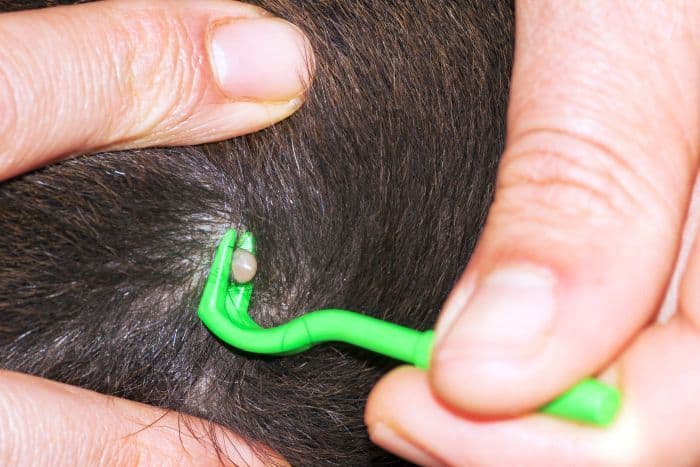
How Do You Remove a Tick from Your Dog?
You may occasionally find it necessary to remove a tick from your dog’s skin, especially if you aren’t careful to reapply the products you use to protect your dog on the proper schedule.
Additionally, some products may kill ticks, but allow them to remain attached to your dog.
Fortunately, removing a tick isn’t terribly difficult.
However, it is important to remove them properly to reduce the chances of disease transmission. Unfortunately, there are a number of misleading myths and folk remedies that can actually increase the risk of infection.
Just do the following to have the best chance of avoiding illness for you or your pet:
- Remove ticks by gripping the arachnid’s head carefully with a pair of tweezers and then pulling gently. Pull the tick straight out, without twisting or jerking. Use care not to grip the tick’s body, as this can cause the tick to “spit” blood, bacteria, and other undesirable gunk into the wound. Do your best to avoid pulling the tick’s body free from its head, which may then remain embedded in the skin.
- Place the tick in an alcohol-filled jar to kill and preserve it. Keep the tick for a few weeks, until you are sure neither you nor your pet has become sick. If either of you begins suffering symptoms, take the tick with you to the vet, your doctor, or a tick-identifying laboratory, so that it can be tested for disease-causing organisms.
- Try to avoid touching the tick with bare hands whenever possible. A pair of latex or nitrile gloves will help keep any harmful bacteria or viruses off of your hands.
- Wash the bite wound and your hands with soap and warm water. Use care to avoid touching your eyes, nose, or mouth while handling the tick.
Note that you can also use a tick remover rather than a pair of tweezers to pull the bug off your pet. Tweezers will certainly work, but some owners find tick removers easier to use.
Do not, under any circumstances, employ folk remedies, such as touching the tick with a match or applying ointments or petroleum jelly to its body.
Often, these types of remedies will irritate the tick and cause it to inject saliva into the wound.
If you need a visual, check out the video from WebMD below showing how to remove a tick from your dog!
Ticks represent a serious health risk to you and your dog, so you’ll always want to do everything you can to avoid these blood-sucking bugs.
Just employ the tick-prevention tips explained above and be sure to treat your pet with a good tick-prevention product.
Has a tick bite ever made you or your dog sick? We’d love to hear about your experiences! Tell us all about your tick story in the comments below.










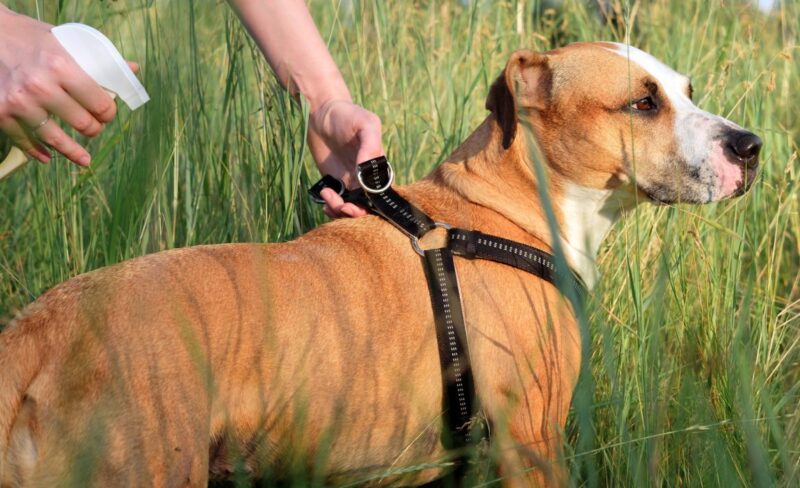
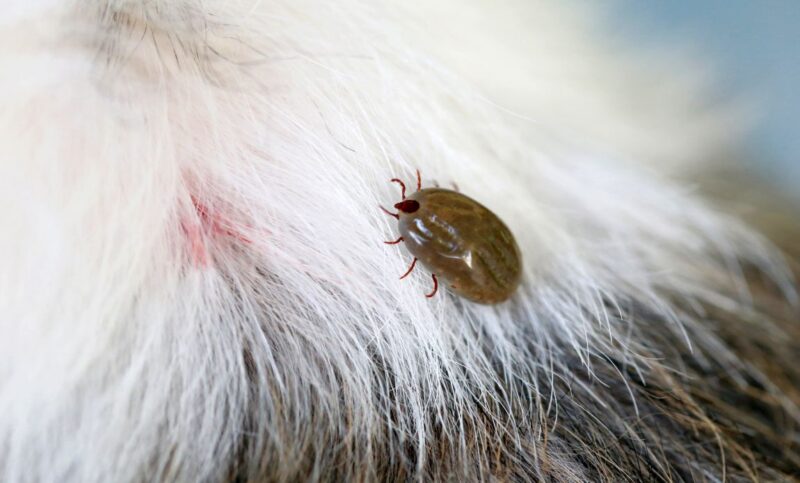

Leave a Comment